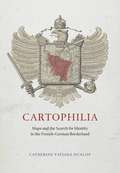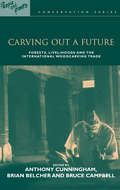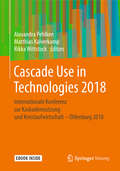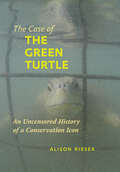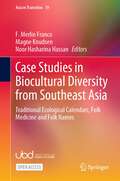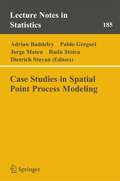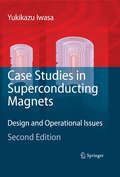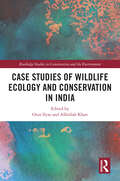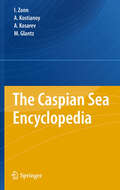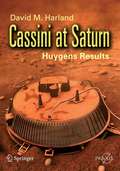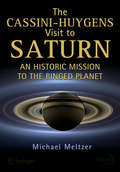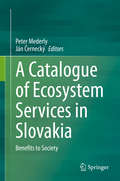- Table View
- List View
Cartophilia: Maps and the Search for Identity in the French-German Borderland
by Catherine Tatiana DunlopThe period between the French Revolution and World War II was a time of tremendous growth in both mapmaking and map reading throughout Europe. There is no better place to witness this rise of popular cartography than in Alsace-Lorraine, a disputed borderland that the French and Germans both claimed as their national territory. Desired for its prime geographical position and abundant natural resources, Alsace-Lorraine endured devastating wars from 1870 to 1945 that altered its borders four times, transforming its physical landscape and the political allegiances of its citizens. For the border population whose lives were turned upside down by the French-German conflict, maps became essential tools for finding a new sense of place and a new sense of identity in their changing national and regional communities. Turning to a previously undiscovered archive of popular maps, Cartophilia reveals Alsace-Lorraine’s lively world of citizen mapmakers that included linguists, ethnographers, schoolteachers, hikers, and priests. Together, this fresh group of mapmakers invented new genres of maps that framed French and German territory in original ways through experimental surveying techniques, orientations, scales, colors, and iconography. In focusing on the power of “bottom-up” maps to transform modern European identities, Cartophilia argues that the history of cartography must expand beyond the study of elite maps and shift its emphasis to the democratization of cartography in the modern world.
Cartophilia: Maps and the Search for Identity in the French-German Borderland
by Catherine Tatiana DunlopThe period between the French Revolution and World War II was a time of tremendous growth in both mapmaking and map reading throughout Europe. There is no better place to witness this rise of popular cartography than in Alsace-Lorraine, a disputed borderland that the French and Germans both claimed as their national territory. Desired for its prime geographical position and abundant natural resources, Alsace-Lorraine endured devastating wars from 1870 to 1945 that altered its borders four times, transforming its physical landscape and the political allegiances of its citizens. For the border population whose lives were turned upside down by the French-German conflict, maps became essential tools for finding a new sense of place and a new sense of identity in their changing national and regional communities. Turning to a previously undiscovered archive of popular maps, Cartophilia reveals Alsace-Lorraine’s lively world of citizen mapmakers that included linguists, ethnographers, schoolteachers, hikers, and priests. Together, this fresh group of mapmakers invented new genres of maps that framed French and German territory in original ways through experimental surveying techniques, orientations, scales, colors, and iconography. In focusing on the power of “bottom-up” maps to transform modern European identities, Cartophilia argues that the history of cartography must expand beyond the study of elite maps and shift its emphasis to the democratization of cartography in the modern world.
Carving out a Future: "Forests, Livelihoods and the International Woodcarving Trade"
by Brian Belcher Bruce M Campbell Anthony CunninghamVery little has yet been written about the cultural or economic contributions of woodcarving to people's livelihoods or the consequences of felling hardwood and softwood trees for the international woodcarving trade. Carving Out a Future is the first examination of this trade and its critical links to rural livelihoods, biodiversity, conservation, forestry and the international trade regime. A range of case studies from Australia, Bali, India,Africa and Mexico provides a lens for examining the critical issues relating to the significant impacts of woodcarving on forests, conservation efforts, the need to promote sustainable rural livelihoods and efforts to promote trade so that skilled artisans in developing countries get a fair economic return. Livelihoods, Carving and Conservation * Global Overview * The Case of Woodcarving in Kenya * Drums and Hornbills * Sculpture and Identity * Carving Wood in Southern Zimbabwe * The Kiaat Woodcrafters of Bushbuckridge, South Africa * Carvers, Conservation and Certification in India * Colour, Sustainability and Market Sense in Bali * Aboriginal Woodcarvers in Australia * BurseraWoodcarving in Oaxaca, Mexico * Linaloe Wood Handicrafts * Learning from a Comparison of Cases * Carving, Sustainability and Scarcity * Certification of Woodcarving * Planning for Woodcarving in the 21st Century *
Carving out a Future: "Forests, Livelihoods and the International Woodcarving Trade"
by Brian Belcher Bruce M Campbell Anthony CunninghamVery little has yet been written about the cultural or economic contributions of woodcarving to people's livelihoods or the consequences of felling hardwood and softwood trees for the international woodcarving trade. Carving Out a Future is the first examination of this trade and its critical links to rural livelihoods, biodiversity, conservation, forestry and the international trade regime. A range of case studies from Australia, Bali, India,Africa and Mexico provides a lens for examining the critical issues relating to the significant impacts of woodcarving on forests, conservation efforts, the need to promote sustainable rural livelihoods and efforts to promote trade so that skilled artisans in developing countries get a fair economic return. Livelihoods, Carving and Conservation * Global Overview * The Case of Woodcarving in Kenya * Drums and Hornbills * Sculpture and Identity * Carving Wood in Southern Zimbabwe * The Kiaat Woodcrafters of Bushbuckridge, South Africa * Carvers, Conservation and Certification in India * Colour, Sustainability and Market Sense in Bali * Aboriginal Woodcarvers in Australia * BurseraWoodcarving in Oaxaca, Mexico * Linaloe Wood Handicrafts * Learning from a Comparison of Cases * Carving, Sustainability and Scarcity * Certification of Woodcarving * Planning for Woodcarving in the 21st Century *
Cascade Use in Technologies 2018: Internationale Konferenz zur Kaskadennutzung und Kreislaufwirtschaft – Oldenburg 2018
by Alexandra Pehlken Matthias Kalverkamp Rikka WittstockThe conference addresses general topics on how products and materials can be recycled and looks for application examples. The focus is on the areas:· Material and Energy Flow Assessment· Sustainable Mobility· Industrial Ecology with a focus on renewable energy sources or WEEE· (Re-) Manufacturing· Cascade Use and Waste Management 4.0
The Case of the Green Turtle: An Uncensored History of a Conservation Icon
by Alison RieserThe journals of early maritime explorers traversing the Atlantic Ocean often describe swarms of sea turtles, once a plentiful source of food. Many populations had been decimated by the 1950s, when Archie Carr and others raised public awareness of their plight. One species, the green turtle, has been the most heavily exploited due to international demand for turtle products, especially green turtle soup. The species has achieved some measure of recovery due to thirty years of conservation efforts, but remains endangered. In The Case of the Green Turtle, Alison Rieser provides an unparalleled look into the way science and conservation interact by focusing on the most controversial aspect of green turtle conservation—farming. While proponents argued that farming green sea turtles would help save them, opponents countered that it encouraged a taste for turtle flesh that would lead to the slaughter of wild stocks. The clash of these viewpoints once riveted the world.Rieser relies on her expertise in ocean ecology, policy, and law to reveal how the efforts to preserve sea turtles changed marine conservation and the way we view our role in the environment. Her study of this early conservation controversy will fascinate anyone who cares about sea turtles or the oceans in which they live.
The Case of the Green Turtle: An Uncensored History of a Conservation Icon
by Alison RieserThe journals of early maritime explorers traversing the Atlantic Ocean often describe swarms of sea turtles, once a plentiful source of food. Many populations had been decimated by the 1950s, when Archie Carr and others raised public awareness of their plight. One species, the green turtle, has been the most heavily exploited due to international demand for turtle products, especially green turtle soup. The species has achieved some measure of recovery due to thirty years of conservation efforts, but remains endangered. In The Case of the Green Turtle, Alison Rieser provides an unparalleled look into the way science and conservation interact by focusing on the most controversial aspect of green turtle conservation—farming. While proponents argued that farming green sea turtles would help save them, opponents countered that it encouraged a taste for turtle flesh that would lead to the slaughter of wild stocks. The clash of these viewpoints once riveted the world.Rieser relies on her expertise in ocean ecology, policy, and law to reveal how the efforts to preserve sea turtles changed marine conservation and the way we view our role in the environment. Her study of this early conservation controversy will fascinate anyone who cares about sea turtles or the oceans in which they live.
Case Studies in Biocultural Diversity from Southeast Asia: Traditional Ecological Calendars, Folk Medicine and Folk Names (Asia in Transition #19)
by Noor Hasharina Hassan F. Merlin Franco Magne KnudsenThis open access book demonstrates the linkages between local languages, traditional knowledge, and biodiversity at the landscape level in Asia, providing a fresh approach to discussions on Asia’s biocultural diversity. The book carries forward earlier analyses but importantly focuses on ‘traditional ecological calendars,’ ‘folk medicine,’ and ‘folk names’ in the context of the vital importance of maintaining biological, cultural, and linguistic diversity. It does this by addressing a range of cases and issues in relation to Southeast Asia: Brunei Darussalam, Indonesia, Malaysia, the Philippines, and North-East India. The several chapters demonstrate the ways in which the various forms of knowledge of the environment and its categorizations are important in areas such as landscape and resource management and conservation. They also demonstrate that environmental knowledge and the practical skills which accompany it are not necessarily widely shared. This book sends important messages to those who care about the sustainability of our environment, the maintenance of its biocultural diversity, or at least the maintenance of what remains of it because much has changed. This interdisciplinary collection draws from a wide range of disciplines and is of appeal to students and scholars in anthropology, environmental studies, geography, biodiversity, and linguistics.
Case Studies in Spatial Point Process Modeling (Lecture Notes in Statistics #185)
by Adrian Baddeley Pablo Gregori Jorge Mateu Mahiques Radu Stoica Dietrich StoyanPoint process statistics is successfully used in fields such as material science, human epidemiology, social sciences, animal epidemiology, biology, and seismology. Its further application depends greatly on good software and instructive case studies that show the way to successful work. This book satisfies this need by a presentation of the spatstat package and many statistical examples. Researchers, spatial statisticians and scientists from biology, geosciences, materials sciences and other fields will use this book as a helpful guide to the application of point process statistics. No other book presents so many well-founded point process case studies. From the reviews: "For those interested in analyzing their spatial data, the wide variatey of examples and approaches here give a good idea of the possibilities and suggest reasonable paths to explore." Michael Sherman for the Journal of the American Statistical Association, December 2006
Case Studies in Superconducting Magnets: Design and Operational Issues
by Yukikazu IwasaThe 2nd edition emphasizes two areas not emphasized in the 1st edition: 1) high-temperature superconductor (HTS) magnets; 2) NMR (nuclear magnetic resonance) and MRI (magnetic resonance imaging) magnets. Despite nearly 40 years of R and D on superconducting magnet technology, most areas, notably fusion and electric power applications, are still in the R and D stage. One exception is in the area of NMR and MRI. NMR magnets are very popular among chemists, biologists, genome scientists, and most of all, by drug manufacturers for drug discovery and development. MRI and NMR magnets have become the most successful application of superconducting magnet technology and this trend should continue. The 2nd edition will have new materials never treated formally in any other book of this kind. As with the 1st, most subjects will be presented through problem format to educate and train the designer.
Case Studies in Sustainability Management: The oikos collection Vol. 3
by Jordi Vives GabrielWith the rapidly growing importance of sustainability and corporate responsibility in a globalised world, management schools are increasingly integrating long-term economic, environmental and social issues into their teaching and research. Climate change, poverty, labour standards and human rights are among the many topics that future decision-makers will need to face in their careers. Business education needs to reflect this new reality and provide a broadened understanding of value creation in order to create economic capital while developing social and preserving natural capital. Case studies can be important tools for creating learning processes on different levels - students are forced to struggle with exactly the kinds of decisions and dilemmas managers confront every day. In this reflection of reality, the values and goals of the student are systematically challenged. This can be especially valuable in the context of sustainability management - organisations are now continually forced to value the different aspects of sustainability and their interrelations: How do social issues impact the economic bottom line? How can an environmentally sound strategy create a positive impact on employee motivation and thus have measurable impact on economic performance? What comes first and why? This third collection of oikos case studies is based on the winning cases from the 2010 to 2013 annual case competition. So what makes an excellent case in sustainability management? These cases have been highly praised because they provide excellent learning opportunities, tell engaging stories, deal with recent situations, include quotations from key actors, are thought-provoking and controversial, require decision-making and provide clear take-aways. These cases are clustered in three different sections: "Large Corporations and Corporate Sustainability Dilemmas" , "Managing Stakeholder Relations" and "Sustainability as a Source of Differentiation Strategies".Case Studies in Sustainability Management will be an essential purchase for educators and is likely to be a widely used as a course textbook at all levels of management education. Online Teaching Notes to accompany each chapter are available on request with the purchase of the book.
Case Studies in Sustainability Management: The oikos collection Vol. 3
by Jordi Vives GabrielWith the rapidly growing importance of sustainability and corporate responsibility in a globalised world, management schools are increasingly integrating long-term economic, environmental and social issues into their teaching and research. Climate change, poverty, labour standards and human rights are among the many topics that future decision-makers will need to face in their careers. Business education needs to reflect this new reality and provide a broadened understanding of value creation in order to create economic capital while developing social and preserving natural capital. Case studies can be important tools for creating learning processes on different levels - students are forced to struggle with exactly the kinds of decisions and dilemmas managers confront every day. In this reflection of reality, the values and goals of the student are systematically challenged. This can be especially valuable in the context of sustainability management - organisations are now continually forced to value the different aspects of sustainability and their interrelations: How do social issues impact the economic bottom line? How can an environmentally sound strategy create a positive impact on employee motivation and thus have measurable impact on economic performance? What comes first and why? This third collection of oikos case studies is based on the winning cases from the 2010 to 2013 annual case competition. So what makes an excellent case in sustainability management? These cases have been highly praised because they provide excellent learning opportunities, tell engaging stories, deal with recent situations, include quotations from key actors, are thought-provoking and controversial, require decision-making and provide clear take-aways. These cases are clustered in three different sections: "Large Corporations and Corporate Sustainability Dilemmas" , "Managing Stakeholder Relations" and "Sustainability as a Source of Differentiation Strategies".Case Studies in Sustainability Management will be an essential purchase for educators and is likely to be a widely used as a course textbook at all levels of management education. Online Teaching Notes to accompany each chapter are available on request with the purchase of the book.
Case Studies of Wildlife Ecology and Conservation in India (Routledge Studies in Conservation and the Environment)
by Orus Ilyas Afifullah KhanThis volume brings together a collection of case studies examining wildlife ecology and conservation across India. The book explores and examines a wide range of fauna across different terrains and habitats in India, revealing key issues and concerns for biodiversity conservation, with a particular emphasis on the impact of humans and climate change. Cases are as wide ranging as tigers, leopards, sloth bears, pheasants, insects and birds, across a diverse range of landscapes, including forests, wetlands, nature reserves and even a university campus. Split into three parts, Part I focuses on how the distribution of animals is influenced by the availability of resources such as food, water, and space. Chapters examine key determinants, such as diet and prey and habitat preferences, with habitat loss also being an important factor. In Part II, chapters examine human-wildlife interactions, dealing with issues such as the impact of urbanization, the establishment of nature reserves and competition for resources. The book concludes with an examination of landscape ecology and conservation, with chapters in Part III focusing on habitat degradation, changes in land-use patterns and ecosystem management. Overall, the volume not only reflects the great breadth and depth of biodiversity in India, but offers important insights to the challenges facing biodiversity conservation not only in this region, but worldwide. This volume will be of great interest to students and scholars of wildlife ecology, conservation biology, biodiversity conservation and the environmental sciences more broadly.
Case Studies of Wildlife Ecology and Conservation in India (Routledge Studies in Conservation and the Environment)
by Orus Ilyas and Afifullah KhanThis volume brings together a collection of case studies examining wildlife ecology and conservation across India. The book explores and examines a wide range of fauna across different terrains and habitats in India, revealing key issues and concerns for biodiversity conservation, with a particular emphasis on the impact of humans and climate change. Cases are as wide ranging as tigers, leopards, sloth bears, pheasants, insects and birds, across a diverse range of landscapes, including forests, wetlands, nature reserves and even a university campus. Split into three parts, Part I focuses on how the distribution of animals is influenced by the availability of resources such as food, water, and space. Chapters examine key determinants, such as diet and prey and habitat preferences, with habitat loss also being an important factor. In Part II, chapters examine human-wildlife interactions, dealing with issues such as the impact of urbanization, the establishment of nature reserves and competition for resources. The book concludes with an examination of landscape ecology and conservation, with chapters in Part III focusing on habitat degradation, changes in land-use patterns and ecosystem management. Overall, the volume not only reflects the great breadth and depth of biodiversity in India, but offers important insights to the challenges facing biodiversity conservation not only in this region, but worldwide. This volume will be of great interest to students and scholars of wildlife ecology, conservation biology, biodiversity conservation and the environmental sciences more broadly.
Case Study: Operationalization and Challenges at a UK Textile Company (Kogan Page Case Study Library)
by David B. Grant Piyya Muhammad Rafi-Ul-Shan Patsy Perry DrThe fashion industry has a high environmental impact in terms of its carbon, water and waste footprint, and is therefore facing increased pressure from multiple stakeholders to balance environmental, social and economic needs - the triple bottom line. Managing Sustainability in the Fashion Supply Chain presents examples of sustainability initiatives used in companies such as M&S and H&M, and looks at the major challenges which are often encountered when trying to incorporate sustainability measures into a company strategy.Aimed at students on manufacturing, retail, supply chain management and logistics courses, this case study explores sustainable initiatives. Managing Sustainability in the Fashion Supply Chain offers readers insights into how to meet the triple bottom line and become more sustainable. Register for a Kogan Page account at check-out to access and download your PDF after purchasing. You'll also have an opportunity to sign up when receiving your purchase confirmation email.
Case Study: Operationalization and Challenges at a UK Textile Company (Kogan Page Case Study Library)
by David B. Grant Piyya Muhammad Rafi-Ul-Shan Patsy Perry DrThe fashion industry has a high environmental impact in terms of its carbon, water and waste footprint, and is therefore facing increased pressure from multiple stakeholders to balance environmental, social and economic needs - the triple bottom line. Managing Sustainability in the Fashion Supply Chain presents examples of sustainability initiatives used in companies such as M&S and H&M, and looks at the major challenges which are often encountered when trying to incorporate sustainability measures into a company strategy.Aimed at students on manufacturing, retail, supply chain management and logistics courses, this case study explores sustainable initiatives. Managing Sustainability in the Fashion Supply Chain offers readers insights into how to meet the triple bottom line and become more sustainable. Register for a Kogan Page account at check-out to access and download your PDF after purchasing. You'll also have an opportunity to sign up when receiving your purchase confirmation email.
Case Study: Case Studies of the Garment Manufacturing and Offshore Construction Industries (Kogan Page Case Study Library)
by Patsy Perry Dr Mohamed Abdel-WahabThis case study focuses on a UK-based designer knitwear manufacturer and retailer, involved in global outsourcing and retailing activities of own-brand products as well as contract manufacturing for other fashion brands.The case analyses the high environmental impact of the fashion industry, in terms of its carbon, water and waste footprint. It is under increased pressure from various stakeholders to balance the triple bottom line (TBL); environmental, social and economic needs. The case study highlights the difficulties in managing global supply chains when it comes to corporate social responsibility and protecting workers' interests. It also illustrates how a region's labour laws and historical relationships with Western clients can embed the importance of ethical behaviour alongside modern cost and lead time cutting demands. The authors examine globally dispersed fashion supply chains which have potentially negative impacts for people and the planet. It highlights the fact that for fashion businesses, it's a challenge to incorporate sustainability when the critical success factors are cost efficiency and effectiveness. Aimed at students on logistics, supply chain management and fashion courses, readers are provided with tools and ideas for sustainability and presented with questions about challenges to the fashion industry as well as some interesting suggested solutions.
Case Study: Collaborative Distribution Considering Economic and Environmental Performance (Kogan Page Case Study Library)
by Vahid Mirzabeiki DrCollaborative Distribution Considering Economic and Environmental Performance provides guidance on how to make the operations of a company more efficient and more eco-friendly. Aimed at students on logistics, operations and supply chain management courses, this case study demonstrates how to make the most of benefits associated with becoming green. Collaborative Distribution Considering Economic and Environmental Performance includes a series of logistics challenges which the reader is encouraged to resolve and offers tips for best practice. The author also analyses ways to exploit an enhanced reputation as a socially responsible company.Register for a Kogan Page account at check-out to access and download your PDF after purchasing. You'll also have an opportunity to sign up when receiving your purchase confirmation email.
Case Study: Collaborative Distribution Considering Economic and Environmental Performance (Kogan Page Case Study Library)
by Vahid Mirzabeiki DrCollaborative Distribution Considering Economic and Environmental Performance provides guidance on how to make the operations of a company more efficient and more eco-friendly. Aimed at students on logistics, operations and supply chain management courses, this case study demonstrates how to make the most of benefits associated with becoming green. Collaborative Distribution Considering Economic and Environmental Performance includes a series of logistics challenges which the reader is encouraged to resolve and offers tips for best practice. The author also analyses ways to exploit an enhanced reputation as a socially responsible company.Register for a Kogan Page account at check-out to access and download your PDF after purchasing. You'll also have an opportunity to sign up when receiving your purchase confirmation email.
Cased-Hole Log Analysis and Reservoir Performance Monitoring
by Richard M. BatemanThis book addresses vital issues, such as the evaluation of shale gas reservoirs and their production. Topics include the cased-hole logging environment, reservoir fluid properties; flow regimes; temperature, noise, cement bond, and pulsed neutron logging; and casing inspection. Production logging charts and tables are included in the appendices. The work serves as a comprehensive reference for production engineers with upstream E&P companies, well logging service company employees, university students, and petroleum industry training professionals.
The Caspian Sea Encyclopedia (Encyclopedia of Seas)
by Igor S. Zonn Aleksey N Kosarev Michael Glantz Andrey G. Kostianoy“The Caspian Sea Encyclopedia” is the second one in the new series of encyclo- dias about the seas of the former Soviet Union published by Springer-Verlag. The ?rst volume – “The Aral Sea Encyclopedia” was published by Springer in 2009. The series will be continued by “The Black Sea Encyclopedia” in 2010. Today the Caspian Sea is known to readers thanks to its oil and gas resources, sturgeon and caviar, signi?cant sea-level variations, socio-economic and political problems. The Caucasus and Central Asia (http://eurodialogue. org/?les/fckeditor_?les/Caspian-s- map2. png) vii viii Introduction For more than 250 years the Caspian Sea was shared by two states: Russia (the Soviet Union) and Persia (Iran). After the disintegration of the USSR in 1992, the new independent states of Azerbaijan, Turkmenistan and Kazakhstan have radically changed the political and economic situation in the region. In addition to Russia and Iran, who had determined the situation on the Caspian for a long period, Azerbaijan, Turkmenistan and Kazakhstan are now interested parties, beginning a new stage in the historical development of the Caspian region. This increase in the number of the Caspian legal entities from two to ?ve has given rise to a whole tangle of geopolitical, economic, international legal, ethnic and environmental problems, each of which demands its own approach and settlement mechanism.
Cassini at Saturn: Huygens Results (Springer Praxis Books)
by David M. Harland*Brings the story of the Cassini-Huygens mission and their joint exploration of the Saturnian system right up to date. *Combines a review of previous knowledge of Saturn, its rings and moons, including Titan, with new spacecraft results in one handy volume. *Provides the latest and most spectacular images, which will never have appeared before in book form. *Gives a context to enable the reader to more easily appreciate the stream of discoveries that will be made by the Cassini-Huygens mission. *Tells the exciting story of the Huygens spacecraft’s journey to the surface of Titan.
The Cassini-Huygens Mission: Volume 1: Overview, Objectives and Huygens Instrumentarium
by C. T. RussellThe exploration of the planets is the modem counterpart to the exploration voy ages of old. To reach the new world Columbus had to secure funding from Queen Isabella, outfit his three ships and set sail on a long journey. To explore the Amer ican Pacific Northwest, Lewis and Clark had a similar task of obtaining funding, purchasing equipment and going to points unknown, even though their path was across land and not sea. Today our journey is through space, rather than across land or sea, but we still travel with ships, now spaceworthy craft, rather than seaworthy. Our spacecraft are smaller than the ships of yore, crammed with electronics rather than provisions because man cannot go along on these journeys. We now rely on robots to be our eyes and ears at these distant worlds. Nevertheless, some aspects of exploration have not changed over the centuries. People are still fascinated by these unknown worlds and desire to explore them, and the process of obtaining the large sums of public moneys to finance these journeys still requires much pleading with authorities.
The Cassini-Huygens Visit to Saturn: An Historic Mission to the Ringed Planet (Springer Praxis Books)
by Michael MeltzerCassini-Huygens was the most ambitious and successful space journey ever launched to the outer Solar System. This book examines all aspects of the journey: its conception and planning; the lengthy political processes needed to make it a reality; the engineering and development required to build the spacecraft; its 2.2-billion mile journey from Earth to the Ringed Planet and the amazing discoveries from the mission. The author traces how the visions of a few brilliant scientists matured, gained popularity and eventually became a reality. Innovative technical leaps were necessary to assemble such a multifaceted spacecraft and reliably operate it while it orbited a planet so far from our own. The Cassini-Huygens spacecraft design evolved from other deep space efforts, most notably the Galileo mission to Jupiter, enabling the voluminous, paradigm-shifting scientific data collected by the spacecraft. Some of these discoveries are absolute gems. A small satellite that scientists once thought of as a dead piece of rock turned out to contain a warm underground sea that could conceivably harbor life. And we now know that hiding under the mist of Saturn’s largest moon, Titan, is a world with lakes, fluvial channels, and dunes hauntingly reminiscent of those on our own planet, except that on Titan, it’s not water that fills those lakes but hydrocarbons. These and other breakthroughs illustrate why the Cassini-Huygens mission will be remembered as one of greatest voyages of discovery ever made.
A Catalogue of Ecosystem Services in Slovakia: Benefits to Society
by Peter Mederly Ján ČerneckýThis book provides the first comprehensive assessment of ecosystem services (ES) for the territory of the Slovak Republic. Although the ES approach is widely used for the evaluation of the benefits of natural capital and biodiversity for people, this book has a unique character. It provides an assessment of 18 individual ES, which are divided into three main groups - provisioning, regulatory/supporting and cultural ES. For each of ES, a brief theoretical and methodological overview is given, followed by spatial assessment based on own original methodology and dataset of 40 map layers. Besides, an evaluation of main ES groups and overall ES assessment is realized. This book emphasizes the key role of nature protection areas, large areas of forest ecosystems and mountain and sub-mountain areas, for the preservation of the various functions of the healthy landscape and ecosystems. The complexity of the book guarantees its usefulness - not only as the knowledge base for the territory of Slovakia but also as the methodological tool for worldwide researchers.
